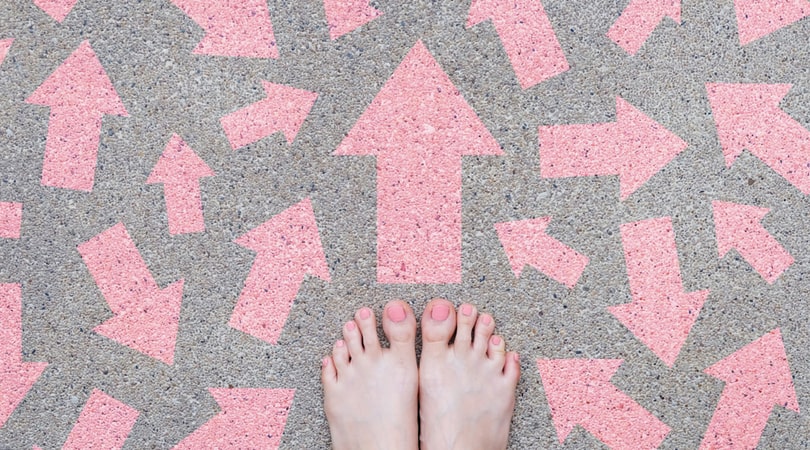Has your IBS diagnosis left you hanging? If you left your doctor’s office with a shiny new diagnosis but no symptom management plan, you may be feeling a little lost right now. Don’t panic! There are lots of ways to effectively manage your IBS symptoms. But, you need to find the right tools to put in your toolbox for your unique body.
In this article, I’ll outline common ways IBS community members manage their IBS symptoms and help you decide if and when you should start the Low FODMAP Diet.

1. Find a FODMAP-trained dietitian
If you have access to a FODMAP-trained dietitian, I definitely recommend setting up a consultation as your first step in your IBS-management plan. A properly trained dietitian can help you comb through your diet for common digestive triggers and may help you find some immediate relief (or at least lessen more aggressive symptoms).
A dietitian can also help you decide which action plan will likely give you the best bang for your buck. This means you won’t waste time trying symptom-management plans that may not benefit you. A dietitian can also keep you from making changes that might actually make your symptoms worse (colon cleanse, anyone?).
Finally, if general IBS hygiene strategies haven’t significantly shifted your symptoms, a FODMAP-trained dietitian can help you set up and work through the Low FODMAP Diet quickly and efficiently.
2. Try implementing IBS-friendly lifestyle changes
IBS sits in each of our bodies differently. That means odds are some of the things that trigger you will be fine for me and vice versa. Similarly, the way we react to triggers will be a little different. That being said, there are some common lifestyle changes that seem to help people with IBS across the board. Check out these general IBS recommendations and see if there is an area where you can start making changes today.
Improve your sleep hygiene
Sleep hygiene isn’t just about how much sleep you get. It’s also about quality. Making sure you get enough high-quality sleep for your body can keep your digestive system functioning at it’s best. So it’s important to take time to make sure you’re sleeping for the right amount of time and in the right environment for you. You can learn more about improving your sleep hygiene here.
Add gentle movement
Gentle movement can help massage the gut, calm your nervous system, and stimulate gentle muscle contractions in the digestive system, all of which can help promote healthy and consistent bowel movements. While movement doesn’t necessarily mean “exercise,” studies have found that low-impact activities like walking, swimming, and yoga can encourage gentle bowel movements in people with IBS.

Stay hydrated
Water is the star of a ton of important bodily functions, including digestion. So, even though it can be a pain, it really is important to be mindful of how much fluid you drink. While there are a ton of recommendations for what your body needs (like 8 glasses of water a day or multiplying your weight by a specific percentage), I encourage my clients to go by the colour and frequency of urination. If your urine is a deep yellow or amber, you need more water. If it’s clear or you’re peeing so frequently it’s getting annoying, you’re drinking too much.
Heads up! If you suffer from constipation, studies have shown that adding extra water doesn’t appear to help produce bowel movements. But, researchers have determined drinking less than 500ml (2 cups) a day can make your constipation worse.
Revamp your stress management plan
While not everyone’s IBS symptoms are triggered by stress, because of the way the brain and the gut are linked together, many people with IBS find stress can be a trigger for their daily symptoms. This means it’s important to find ways to prevent and/or cope with life-stressors as effectively as possible.
I know saying “manage your stress” is easy from this side of the screen. Believe me, I know there may be stressful things happening in your life right now that are out of your control. But, you need to manage the stressors you can. This might involve delegating tasks at home or at work, taking time in your day to take a deep breath and relax, or practicing a short (or long) daily meditation to help soothe your nervous system.
3. Follow an IBS-friendly diet
Contrary to popular opinion, looking for dietary triggers doesn’t necessarily start with the Low FODMAP Diet. Because the low FODMAP program is so restrictive (and when done improperly can damage your gut bacteria), unless your health care team says otherwise, you’ll want to investigate these common triggers first.
Remember to check with your doctor or dietitian before making changes to your diet. Some tests (like the test for celiac disease) require you to consistently eat the food being investigated leading up to the test. Changing up your diet before speaking to your doctor can cause unnecessary delays that can truly impact your health. So it’s always worth touching base with your healthcare team before making changes to your symptom management plan.
Get enough of the right fibre
While fibre can be broken into several sub-groups, there are two types of fibre that are particularly important for people with IBS: soluble and insoluble fibre. Based on the type of IBS you have (constipation, diarrhea, or a mix of both) the type of fibre you choose can either help or hurt you. Check out Stephanie Clairmont’s article What’s all the Fuss About Fibre for a detailed explanation of each fibre type and what it can do for (or to) your IBS.
If you think adding fibre to your diet may be helpful to you, remember to add it slowly (like very, very slowly!). Adding too much fibre to your system at once can cause bloating, cramping, and constipation or diarrhea. So be gentle and remember to add some extra water to your diet to keep things moving smoothly.
General gut irritants
When you’re experiencing chronic digestive issues, make sure you take a close look at these general gut irritants:
- Coffee/alcohol/soda pop
- Artificial sweeteners
- Chocolate
- Spicy foods
- Greasy or overly processed foods
Try cutting out these foods for a week or two and see if you feel any better. If your symptoms improve, try adding them back one item at a time. If your symptoms return after you’ve added something back, you’ve likely identified a trigger. If you don’t see any improvement, you’ll know these items aren’t likely the main culprits behind your symptoms.
Natural diuretics and laxatives
Some of the foods we eat every day are natural diuretics and laxatives which can lead to diarrhea. Try removing these from your diet for a few weeks to see if your symptoms improve.
Natural diuretics
Natural diuretics cause the body to produce urine. They include caffeine (found in coffee, tea, chocolate, candy, sports drinks, soda pop, etc.), many citrus fruits (like lemon or lime, grapefruit, and oranges), and common fruits like pineapples, cherries, and peaches, etc.
Natural laxatives
Most people know prunes are a natural laxative. But, other natural ingredients like licorice, ginger, turmeric, dandelion, and inulin, etc. can also cause diarrhea when eaten in large quantities.
Gums
Gums are also naturally occurring laxatives. Gums can pull excess water into the digestive tract, causing cramping and diarrhea. Not everyone reacts to gums, so you’ll need to check your personal tolerance. If you want more information on gums, Chris Kresser has a great article on common gums in commercial products as well as a great article on xanthan gum, specifically.
It’s worth noting that most gums need to be eaten in very large quantities to have a laxative effect. So don’t panic if you notice gums in some of the products you use regularly.
Common digestive triggers
If making IBS-friendly lifestyle changes, avoiding common gut irritants, and cutting out natural laxatives haven’t relieved your symptoms, you might also consider testing dairy and wheat.
Both dairy and wheat are common culprits when it comes to digestive issues, so they’re a great place to investigate. But both of these items are also tested during the Low FODMAP Diet. So, if you think they may be the culprit behind some of your symptoms, now is the time to make a decision about whether you want to try the low FODMAP diet.
Just so we’re clear, if you and your healthcare team decide to test dairy and wheat first, you won’t need to test them again if you try the Low FODMAP Diet. But, if you test them as part of the low FODMAP program you can test dairy, wheat, and several other common IBS-triggers using one elimination phase.
4. Starting the low FODMAP diet
If making lifestyle and basic dietary changes hasn’t had the impact you hoped for, don’t fret! Now you know your symptoms aren’t caused by a lack of sleep, dehydration, caffeine, fat content, gums, or other common irritants, etc.
These are all important pieces of the puzzle, and the more you know about the inner workings of your IBS, the more efficient you’ll be at managing it when you find the right tools for your toolbox.
If you or your healthcare team suspect you’re IBS is triggered by sneaky FODMAPs, it might be time to start the Low FODMAP Diet.
If you need help getting started, sign up for my free low FODMAP mini-course above. It explains exactly what to expect in each phase of the low FODMAP program, where to get your official list of high and low FODMAP foods, and answers some of my most frequently asked questions.
Final thoughts
If your IBS diagnosis has left you with more questions than answers, you may be wondering what your next steps should be. If you can, try to find a FODMAP trained dietitian. They can help point you toward the most likely culprits in your diet and let you know when if and when to start the low FODMAP diet. Try making some lifestyle changes to improve areas of your life that may trigger or worsen your symptoms. Check your diet for common gut irritants, diuretics and laxatives, and common triggers like dairy, wheat, and gums. If that doesn’t quite do the trick, take the information you’ve learned so far and dive into the Low FODMAP Diet.
You might also like one of these:
- What is the low FODMAP diet? Lots of people are talking about the Low FODMAP Diet these days. Have you ever wondered what it is? Check out this article for a deep dive into each of the three phases of the low FODMAP program and what it can do for you.
- Can you follow a plant-based low FODMAP diet? Wondering if you can combine a plant-based diet with the low FODMAP diet? Yes, you can! Here’s what you need to know!
- How long does it take for the low FODMAP diet to work? Wondering how long it takes to see changes on the low FODMAP diet? Like most things about IBS, the answer is… complicated.


